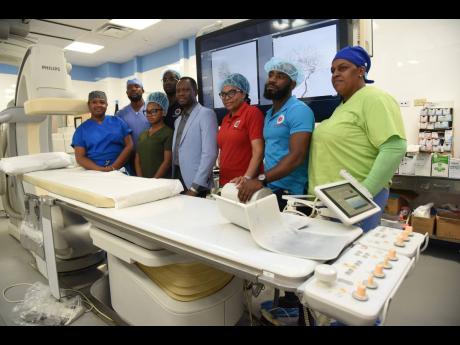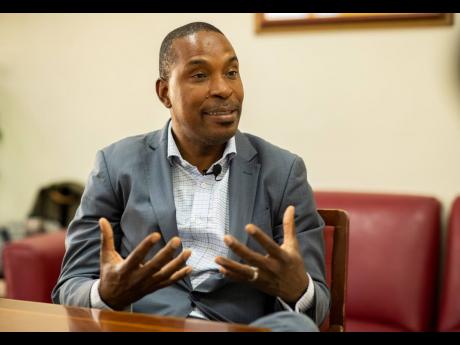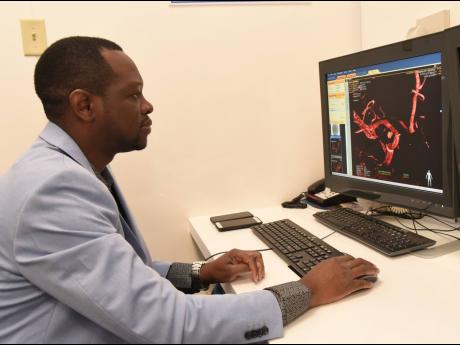Tackling strokes
UHWI adapts to growing cases with advanced treatment methods
Once thought of as an ailment predominantly affecting older adults, strokes are now increasingly impacting younger Jamaicans, including those in their 30s.
Local experts have identified this trend of patients over 18 having this affliction as ‘young stroke’ or ‘stroke in the young’. When the condition affects children and adolescents, it is called a paediatric stroke.
While some risk factors for strokes in younger adults overlap with those in older adults – such as smoking, heavy drinking, diabetes, high blood pressure, and high cholesterol – there are also distinct factors at play, he experts said.
Jamaican officials have observed a rising trend in obesity, hypertension, and diabetes within the population, all of which contribute to the increasing incidence of stroke.
“Yes, we have seen individuals in their 30s becoming victims of stroke,” Dr Carl Bruce, consultant neurosurgeon and medical chief of staff at The University Hospital of the West Indies (UHWI), told The Sunday Gleaner recently.
Young stroke “refers to ischemic or haemorrhagic strokes occurring in adults aged less than 65 years”.
In some jurisdictions, stroke in the young is seen as happenning between the ages of 18 and 45.
Bruce, a cerebrovascular specialist, and Dr Kevin Wade, a consultant neurosurgeon and the primary vascular specialist at the UHWI, collaborate in one of two specialised firms at the hospital that focuses on treating and managing patients with brain injuries. Wade addresses conditions such as brain aneurysms, blood vessel abnormalities, and brain arteriovenous malformations (AVMs), while Bruce brings extensive experience in open surgery to complement their work.
Wade said the UHWI has invested heavily in facilities, resources and personnel to treat brain injuries, noting a more modern approach moving away from open surgery to a less invasive method of intervention.
“You get something like a drip; that’s all you have,” he explained. “So when the procedure is done, the only thing you will see is a little spot where we put in a catheter. So the same way the cardiac surgeon will put in a catheter in a small artery, it’s the same, exact work that we do. So it’s all through the arteries, all through the blood vessels.”
He noted, however, that while there may be less reliance on open surgery, it still coexists with keyhole (endovascular) surgery.
Wade told The Sunday Gleaner that when the stroke centre opened, the numbers of person seeking treatment became overwhelming for one specialist and additional skills were brought on board.
“The UHWI’s strategy is to build technology [and] expertise to meet the needs of the population at large and so the [hospital] has done a lot of work in AVM and aneurysm treatments … ,” he said.
URGENCY KEY
Deprived of oxygen, brain cells begin to die. Every minute a stroke goes untreated, roughly 1.9 million brain cells die, which can lead to long-term disability and even death.
Symptoms of a stroke may include sudden confusion, trouble speaking, or trouble understanding speech; numbness or weakness, especially on one side of the body; severe headache with no known cause; and trouble seeing from one or both eyes.
Wade said if the signs and symptoms of strokes are detected, a person should be brought to the hospital right away to see a doctor immediately.
He explained that upon arrival at the UHWI, patients are initially assessed by first responders in the Accident and Emergency (A&E) Department, where a preliminary diagnosis of a possible stroke is made. Following this, a CT scan is performed, and specialists are called in to assume the patient’s care. This entire process is ideally completed within an hour to ensure that life-saving treatment can be administered promptly.
Given the overcrowding in the hospital’s A&E department at times, completing all the necessary processes and having patients seen by stroke specialists within an hour can be challenging. However, Wade emphasised that the goal remains to achieve a prompt diagnosis and initiate treatment as quickly as possible.
“That’s what we are trying to build here. In so doing, we can administer clot-busting drugs to break down the clot and stop the stroke, which is a blockage. ... In some cases, we can go a bit further by using a mechanical suction catheter to suction out the clot. Rather than simply relying on the medication to dissolve it, you can put a catheter – a little tube – right up to the top and suck it out of the blood vessel,” the neurosurgeon explained.
In many US hospitals, the clot-busting drug is administered and then patients are sent to the intervention suite for treatment, similar to what they now offer at UHWI.
“With the new standard of care, strokes can be stopped or even reversed,” Wade told The Sunday Gleaner.
The cost of basic medications, with one drug priced at $500,000, often presents a significant financial challenge for stroke victims and their families.
In July, Wade, in collaboration with neurosurgeon Dr Ronetta Goodluck and with the UHWI’s assistance in waiving fees, was able to clear a backlog of surgeries for stroke patients.
Commenting on the costs associated with surgery and necessary resources, Wade noted that a team of volunteers from the US, alongside local specialists, was able to perform six urgent surgeries. Although 15 surgeries were planned, some promised contributions did not come through, resulting in only six being completed. Nevertheless, all patients who underwent the procedures were successfully treated.
JAMAICAN CONCERN
Dr Gillian Gordon Perue is a stroke specialist and associate professor of clinical neurology. She is also chief of neurology at the Jackson South and the Jackson West medical centres in Florida. The University of the West Indies-trained medic said she is aware of the programme at the UHWI and works closely with doctors in Jamaica.
“The phrase we use is strokes in the young, and the classical definition is strokes occurring before the age of 45 years. Traditionally, when you had strokes in the young, you think of really young babies with perinatal stroke – which can happen in the womb – or young persons predisposed by hereditary or genetic conditions, creating extra clots, or there is something the blood which increases the risk of having a stroke,” she explained.
Strokes in younger individuals prompt specialists like Gordon Perue to investigate more thoroughly to determine the underlying causes.
“In the last few years, the classic stroke risk factors are now creeping into the young persons. So the classic stroke risk factors when you are older are high blood pressure, diabetes, high cholesterol. With our diet being what it is, you now start to see strokes happening with younger and younger age. And we have found that in countries like Jamaica, stokes happen a decade earlier than in First World countries,” Gordon Perue explained.
While Jamaica sees some 7,300 stroke cases annually with roughly 2,400 deaths, The Sunday Gleaner was unable to get specific data on young stroke but the experts noted that there has been an increase in such cases.
Some 68 per cent of local stroke victims are hypertensive, more than 30 per cent diabetic, and some 27 per cent are smokers. The prevalence of high blood pressure is almost 40 per cent in Jamaicans over 15 years old, with a higher prevalence among women.
With limited epidemiological data on strokes, Gordon Perue said she would like to spearhead such a registry. However, based on surveys conducted at several local hospitals, the median age range for stroke patients is 44-54 years, compared to a median age of 72 years in the United States.
The Ministry of Health and Wellness launched a Know Your Numbers campaign last year to screen Jamaicans for blood pressure, blood sugar, body mass index and cholesterol. Eye screenings as well as sexual and reproductive health and oral health screenings are also done. The campaign is targeting 400,000 screenings and follow-ups this year.
Gordon Perue fully supports the campaign, emphasising the need for increased awareness and action. She pointed out that many cases of young stroke could be linked to sickle cell disease, a prevalent genetic condition.
“Know you numbers. Go and get checked out, and figure out your prevention strategy, and then, recognise that stroke is not just preventable but treatable. You need to now the symptoms when you are having a stroke in that moment so that you can present to hospital quickly to get the right treatment, which can mean the difference between life and death or severe disabilities,” she stressed.
“Knowing the signs and symptoms to react quickly is really important. That campaign is very important for everybody, not just for persons over 45 years,” she said, noting that one did not have to be obese to have worrying numbers.
For his part, Health Minister Dr Christopher Tufton said he is pleased with the work of the UHWI regarding the treatment of strokes.
“We promote programmes like Know Your Numbers so that enough people can get screened as too many don’t know until they have heart attack and strokes,” he told The Sunday Gleaner.



